WEAPONS
Below are some weapons commonly found in the Matrix. Players
and GM's should feel free to alter and add weapons as they see fit.
This list is only preliminary.
Terms:
BDV (Base Damage Value): This is the standard damage that
the weapon can do. Roll the given dice code and count the number
of successes. If there is a multiplier adjacent to the dice code,
multiply the number of successes by this number. The final sum is
the amount of damage done by the weapon. If a character has a Strength/Lifting
bonus, add this value to the total damage for melee and thrown weapons
only.
Range: The range in meters of a weapon. Difficulties
increase with greater distance (see Actions
and Combat).
Scale: Indicates the scale of the weapon when deciding
damage.
Difficulty: The difficulty number the user must equal or
surpass in order to hit.
Concealability: A measure of how difficult it is to conceal
the weapon under clothes. GM's may modify this depending on the kind
of clothes worn (increased difficulty if only an evening gown is worn,
bonuses is an overcoat is worn).
MELEE WEAPONS
Typical Knife
BDV: 2D
Range: 3/10/15 (thrown)
Scale: Character
Skill: Melee Weapons: Knife, Thrown Weapons: Knife
Difficulty: Easy
Concealability: Very Easy
Note: A typical knife can be thrown, but increase the
difficulty by 5. Knives are readily available in both the Real World
and the Matrix.
Sword
BDV: 4D)
Scale: Character
Range: 0
Skill: Melee Weapons: Sword
Difficulty: Easy (2)
Concealability: Difficult.
Note: Swords are very rare in the Real World. Most
are artifacts and are considered to be very valuable. Because of
the awkwardness, it is rare that someone will carry a sword in the Matrix
(though some have been known to play games in the Contructs with them).
Club/Baseball Bat
BDV: 3D
Scale: Character
Skill: Melee Weapons: Club
Difficulty: Easy
Concealability: Moderate
Notes: Clubs are any blunt object made to hit something
else hard. GM's should alter the damage rating depending on the quality
of the club. For example, a broom stick might only do 2D of damage
while a crowbar might do 4D.
FIREARMS
The guns listed here are pretty basic. For much more detailed
lists of firearms, check out Joe's Gun Catalog
or Aaron LaBow's weapons list in PDF
or Word 2000 formats. You can use the ranges
given below for the weapons that Joe lists (or the ranges listed by Aaron).
Handgun
BDV: 5Dx2
Ammo: 6 (revolver) to 12 (automatic)
Range: 3-10/25/50
ROF: 3 shots per round maximum. No burst.
Concealability: Very Easy
High-powered Handgun
BDV: 5Dx3
Ammo: 6 (revolver) to 12 (automatic).
Range: 3-7/25/50
ROF: 2 shots per round maximum. No burst.
Concealability: Easy (7)
Notes: -1 pip to all "To-Hit" rolls.
Machine Pistol
BDV: 4Dx3 (see below)
Ammo: 15
Range: 3-7/15/25
ROF: Single: 3 shots per round. Semi-automatic: 2 bursts of
3 bullets rendering 5D damage per burst (roll once per burst). -1D on "To-Hit"
rolls in semi-automatic. Full automatic: Can empty the clip in one round,
either spraying (See Spraying
in the Combat section) or Concentrating Fire resulting in +1D to hit
and 5Dx3 damage.
Concealability: Easy
Submachine Gun
BDV: 5Dx3 (see below)
Ammo: 30
Range: 6-10/20/50
ROF: Single: 3 shots per round. Semi-automatic: 2 bursts of
3 bullets rendering 6Dx3 damage per burst (roll once per burst). -1D on
"To-Hit" rolls in semi-automatic. Full automatic: Can empty the clip in
one round, either spraying (See Spraying in the Combat section) or Concentrating
Fire resulting in +1D to hit and 6Dx4 damage.
Concealability: Easy
Automatic Rifle
BDV: 6Dx3 (see below)
Ammo: 50
Range: 5-20/60/90
ROF: Single: 3 shots per round. Semi-automatic: 2 bursts
of 3 bullets rendering 6Dx4 damage per burst (roll once per burst). -1D
on "To-Hit" rolls in semi-automatic. Full automatic: Can empty the clip
in one round, either spraying (See Spraying in the Combat section) or Concentrating
Fire resulting in +1D to hit and 7Dx4 damage.
Concealability: Very Difficult.
Pump Shotgun
BDV: 5Dx4 (buckshot) / 6Dx4 (solid slug)
Ammo: 5
Range: 2-5/10/20
ROF: 2 shots per round maximum.
Concealability: Difficult for full-barrelled shotguns. Moderate
for sawed-off shotguns.
Notes: Sawed-off shotguns do 6Dx4 damage at Point Blank range
but suffer a -1D cumulative penalty to damage rolls for every 5 meters
beyond the first.
Stun Pistol
Damage: 5Dx3 Stun damage.
Ammo: 15
Range: 3-10/30/60
ROF: 3 shots per round maximum.
Concealability: Very Easy.
Notes: Stun Pistols can look like a normal pistol, or
just about anything else the designer wishes. They are created by
resistance programmers to deliver a "shock" to recipients that disrupts
their input/output flow with the Matrix and renders them immobile.
Stun Rifle
Damage: 7Dx3 Stun Damage.
Ammo: 15
Range: 5-30/100/300
ROF: 3 shots per round maximum for single shot or Burst:
2 bursts of 3 blasts for 7Dx4 damage each (roll separately for each burst).
Concealability: Difficult.
Notes: see notes on stun pistols, though the Rifle must
be larger.
Flamethrower
Damage: 6Dx4
Skill: Heavy Weapons: Flamethrowers
Ammo: 50 burst/3D
Range: 1-4/8/12
ROF: 1 burst per round maximum. Can "spray" an entire
area (about 10m wide) with a hose-like stream that counts as 4 bursts.
Note: Flamethrowers are rare, very bulky, and somewhat
dangerous. If the fuel tank (usually worn on the back) is pierced
or ignited it will do 9D damage to anyone with 5 meters of the blast center
(reduce damage by 1D for each 5 meters from the core blast).
ARMOR
Shield
Type: Personal protection.
Scale: Character.
Armor Value: Free action to Parry a melee attack (roll
with Melee Weapons, Martial Arts or Brawling). Provides an AV of
15 against up to 2 attacks per round (from the same general direction).
Cost: Highly variable (depending on style and quality).
Availability: Uncommon. In the Matrix, hackers may
use a variety of objects as shields (trashcan lids, etc.).
Concealability: Very Difficult (25)
Leather
Type: Personal clothing.
Scale: Character.
Armor Value: 10
Cost: NA.
Availability: Extremely rare artifact in the Real World.
Concealability: Very Easy (but usually unnecessary).
Game Notes: Leather gives versus damage in the Matrix
and the real world.
Kevlar Vest
Type: Personal body armor.
Scale: Character.
Armor Value: 18
Cost: NA.
Availability: Extremely rare artifact in the real world.
Concealability: Moderate.
Game Notes: Grants protection versus perceived damage
in the Matrix, but reduces all Dexterity-based rolls by 1D.
Full Body Armor
Type: Military armor.
Scale: Character.
Armor Value: 25
Cost: NA.
Availability: Extremely rare artifact in the real world.
Concealability: Difficult.
Game Notes: Grants +3D protection versus perceived damage
in the Matrix but reduces all Dexterity-related skill tests and checks
by 2D.
COMPUTERS
Inside the Matrix, the computer technology resembles
that of the late 1990's and early 21st century. Computers are for
the most part non-autonomous and interfaces remain primarily through keyboards
and disk drives.
In the Realworld, computers are extremely advanced
and artificial intelligence is pervasive. The human resistance fighters
have managed to steal and develop impressive technological advances,
including the superfast computers and communication systems needed to jack
into the Matrix.
Hovership Operations/Resistance Hacking Computer
Type: Cybernetic communication device
Cost: NA
Skill: Computer Ops: Resistance Hacking Computer.
Provides +2D to all Hacking attempts.
Availability: Common in Resistance Hoverships/Hackships.
Difficulty to Operate: Moderate.
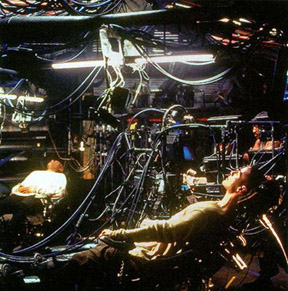 Game
Notes: The Hackers employ advanced computers to monitor and jack
into the Matrix. Much of these computers has been stolen or salvaged
from the Machines and no two computers are identical. Some may have
special sensors, others more advanced A.I.'s. A skilled Operator
must be able to pay attention to multiple screens at one time, while reading
the complex Matrix code, and quickly access information and programs for
his Hackers.
Game
Notes: The Hackers employ advanced computers to monitor and jack
into the Matrix. Much of these computers has been stolen or salvaged
from the Machines and no two computers are identical. Some may have
special sensors, others more advanced A.I.'s. A skilled Operator
must be able to pay attention to multiple screens at one time, while reading
the complex Matrix code, and quickly access information and programs for
his Hackers.
Jump Chairs
Type: Cybernetic communication device
Cost: NA
Skill: Communications: Jump Chair (to use).
Repair Communications: Jump chairs (to fix).
Availability: Common in Resistance Hoverships/Hackships.
Range (kilometers): 1/5/8 to Matrix node that is being
hacked.
Difficulty (or transmission, rolled by the Operator): Very
Easy (1)/ Easy (2)/Difficult (4).
Game Notes: Though very sophisticated, most Jump Chairs
look to be cobbled together from a variety of different components.
They are capable of inserting a link into the cybernetic implants of Rescucitated
Humans and transmitting their minds into the Matrix. Jump Chairs
must be activated and transmitted from by an Operator.
ROBOTS
Sentinel I-Series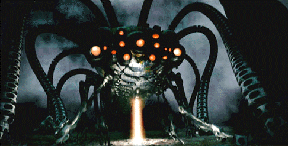
("Squids")
Type: Semi-autonomous Security Unit
Scale: Tank
Dexterity: 4D
Dodge: 5D, Brawling (Tentacles): 5D, Throwing (Squid
Bomb): 7D.
Knowledge: 1D
Mechanical: 3D
Mounted Artillery: Plasma Lasers 5D, Sensors:
6D, Communications: 6D
Perception: 3D
Search: 6D
Strength: 10D (Character scale).
Technical: 1D
Armor Value: 25 (has no effect versus EM Pulses).
Body Points: 60
Strength/Lifting: +5
Equipped with:
-
8 Tentacles (BDV: 6Dx4 + 5 for S/L bonus, Character scale damage)
-
Weapons:
-
1 Large Plasma Laser: 8Dx5 (Hovership Scale). Range: 3/5/10.
-
"Squid Bomb": a smaller version of the Squid that is stored within
the "mother's" carapace. It is released and thrown at hoverships
at ranges beyond the hoverships' EMP weapons.
-
Attack Roll: 7D (Throwing skill)
-
Damage: 16Dx5 (Hovership Scale).
-
Repulsorlift engine: Speed: 80; 300 mph.
-
Communication array: Allows uplink to global satellite communication
system.
-
Sensor Package: Includes advanced optics with telescopic,
infrared and light-enhancement. Also, standard sensors with: Passive:
1 km/0D, Scan 5 km/0D, Search 10 km/1D, Focus 500 meters/2D. Note:
sensor range is for above-ground used and may be restricted when underground,
in cities or otherwise obstructed.
-
Self-destruct Device: If disabled beyond repair, a Sentinel
will destroy itself to avoid passing sensitive technology into human hands.
If a Sentinel is incapable of performing this action (i.e. if disabled
by an EM Pulse, other Sentinels can broadcast a specific code command to
activate the destruct mechanism (each one is unique for each unit and is
kept in the Computer's mainframes under high security). The destruct
mechanism will completely destroy the unit and do 10D (character scale)
to any targets within 50m (reduce damage by 1D for each additional 25m
beyond 50).
Game Notes: The Sentinel I-Series serves as the primary scout
and guard corps for the machines. They work independently, showing
much cunning and resourcefulness. However, they are most dangerous
when working in squads (usually 3-5). They coordinate extremely well
with instantaneous communication among the squad members.
Orderlies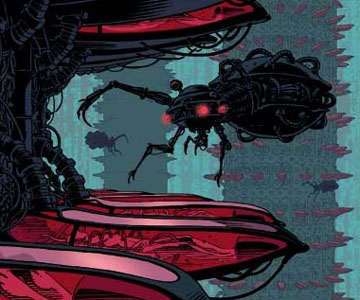
("Docbots")
Type: Clone Farm Operations Unit
Scale: Speeder
Dexterity: 6D
Knowledge: 2D
Mechanical: 5D
Operate Stasis Pods: 7D
Perception: 2D
Search: 5D
Strength: 6D (Character scale).
Technical: 4D
Repair Stasis Pods: 8D, Electrical Engineering:
7D, First Aid: 6D, Medicine: 6D, Cloning:5D, Cybernetics: 7D.
Armor Value: 15 (has no effect versus EM Pulses).
Body Points: 45
Strength/Lifting: +4
Equipped with:
-
4 Spider-like legs protruding from the head with dextrous "finger-claws".
-
Repulsorlift engine: Speed: 10; 100 mph.
-
Communication array: Allows uplink to global satellite communication
system.
-
Sensor Package: Includes advanced optics and audio and audio
sensors.
Game Notes: Orderlies exist solely to monitor stasis pods
and clean out defective battery units (i.e., humans). They generally
ignore any outside stimuli that does not directly bear on their duties.
However, they can coordinate to detect and root out intruders, dispatching
them if necessary.
Nurse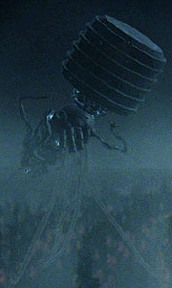
("Beetles")
Type: Clone Farm Operations Unit
Scale: Speeder
Dexterity: 3D
Brawling (Tentacles): 5D
Knowledge: 1D
Mechanical: 4D
Operate Stasis Pods: 6D
Perception: 2D
Search: 4D
Strength: 8D (Character scale).
Technical: 4D
Repair Stasis Pods: 6D, Electrical Engineering:
6D, First Aid: 5D, Medicine: 5D, Cloning: 6D, Cybernetics: 6D.
Armor Value: 15 (has no effect versus EM Pulses).
Body Points: 45
Strength/Lifting: +4
Equipped with:
-
6 Tentacles (5Dx4 + 4 S/L bonus)
-
Repulsorlift engine: Speed: 10; 100 mph.
-
Communication array: Allows uplink to global satellite communication
system.
-
Sensor Package: Includes advanced optics and audio and audio
sensors.
Game Notes: Nurses exist solely to run the farms and are responsible
for the cloning and raising of new humans to serve as power sources.
They generally ignore any outside stimuli that does not directly bear on
their duties. However, they can coordinate to detect and root out
intruders, dispatching them if necessary.
Maintenance 'Bots
("Spiders")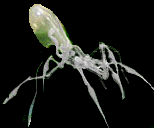
Type: Pod Maintenance Unit
Scale: Character
Dexterity: 4D
Knowledge: 0D
Mechanical: 1D
Perception: 2D
Search: 4D
Strength: 1D (Character scale).
Technical: 6D
Repair Stasis Pods: 8D, Repair Computers:
6D, Repair Robots: 6D
Armor Value: 0
Body Points: 10
Strength/Lifting: 0
Equipped with:
-
6 Legs
-
Communication array: Allows link to local communications grid
(for receiving orders)..
-
Sensor Package: Includes basic optics and audio sensors.
Game Notes: Spiders perform a variety of tasks, from keeping
things clean to performing repairs on other robots. In general, they
take no notice of anything other than broken machines. They scurry
around anywhere there are machines to maintain, often working in large
groups to complete tasks more efficiently.
MISCELLANEOUS GEAR
Communication Gear
Cellular Phones
Availability: Very common.
Concealability: Very Easy.
Difficulty: Very Easy to use. May be traced with
Moderate or Difficult Sensors attempts.
Cell phones are a common item inside the Matrix,
used by both Hackers and unknowing citizens alike. Hackers memorize
special codes (phone numbers) that dial into their Operator. Because
cell phones are fairly easy to trace, Hackers use them only when necessary
and even then only for brief periods. Finally, Hackers cannot access
or escape the Matrix over cellular connections. Cellular technology
is not used in the Realworld because of the ease with which it can be traced.
Hardline Phones
Availability: Uncommon.
Difficulty: Very Easy to use. Moderate to trace.
Concealability: Very Easy.
Scattered throughout the physical representations
of the Matrix are hardline phones that provide access nodes into and out
of the Matrix itself. These phones are actually data relays for the
superstructure of the Matrix, which is why the Machines cannot destroy
all of them. Indeed, each time the Machines destroy a hardline, they
must restablish one elsewhere or lose their ability to inter-communicate.
Not all telephones that are "wired" into a wall jack or telephone box are
"hardlines" that serve as nodes. Only an Operator can scan the system
to find an access-ready hardline.
Radios
Availability: Common.
Concealability: Very Easy.
Difficulty: Easy to Moderate.
Radios provide another method for transmitting communications
within and outside the Matrix, though they cannot be used to communicate
with the Realworld from inside the Matrix (in other worlds, Hackers can
use them to communicate among themselves while in the Matrix, but the Operator
will be unable to hear their communications). Some Hackers employ
radios because the Machines rarely scan their frequencies for Hacker communications
(focuses their energies on cellular and hardlines instead). Further,
many radios may be fit with encryption-decryption gear that will hide their
contents from scans. Some Resistance units make use of old radio
technology in the Realworld as well.
Survival Gear
Food rations (Realworld)
Availability: Common.
Very little food is available in the Realworld.
Since most humans live underground, they must subsist on synthesized food
products (that mainly looks like Malt-o-Meal that's been sitting out for
a few days). It takes like gruel and doesn't really provide a satisfying
meal for the belly, but it has all the nutrients a busy
Resistance fighter needs. Resistance units can easy stow a week's
worth of rations in a thermos or canteen and carry it along on operations.
All hoverships are outfit with a modest galley providing the stuff at will.
Many Hackers take the opportunity to snack while
making a run, though, of course, they are no longer nourished by the food
since they are not hooked up the Machines' feeding tubes. Still,
their tastebuds enjoy the experience. Ironically, Hackers take less
and less joy from pleasant stimuli in while in the Matrix as they achieve
more and more enlightenment--simply because they realize all the stimuli
are falsehoods.
Explosives
Grenades
Scale: Character.
Damage:
-
Standard 4Dx4
-
Fragmentation 5Dx4 (Reduce Armor rating by 1/2). -1D for every 2
meters from point of explosion.
-
High Explosive 5Dx5. -1D for every 5 meters from point of explosion.
-
Phosphorous 6Dx5 (Heat damage). Sprays a sticky, burning substance
all over target with splash effects on anything with 1 meter. Burns
for 5 rounds.
Molotov Cocktails
Scale: Character
Range: 2/4/8
Cost: Very inexpensive--easily Scrounged together if alcohol
or fuel is available.
Damage: 3x4 fire damage. The cocktail's fuel will
splash about 1m in all directions from impact and burn for 1D6 rounds.
Pipebombs
Scale: Character
Range: 2/4/8
Cost: Very inexpensive--easily Scrounged together if explosive
powder is available.
Damage: 4Dx4 damage within 2 meters of explosion.
Reduce damage by 1D for each additional 2 meters from site of impact.
Note: "Pipebombs" include just about every small, makeshift
bomb the characters might whip up.
VEHICLES
With the exception of the Hovership, most of the vehicles below are
used only in the Matrix. Most people born in the Realworld have not
ever seen a motorcycle or car, let alone know how to drive one.
Motorcycle
Scale: Personal Vehicle.
Length: 2 meters.
Cost: Civilian models: $2000 (used); $10,000 (new).
Skill: Drive Motorcycle
Speed: 80 kph / 200 kph.
Body Points: 60
Armor Value: 10 (provides no cover to the driver).
Maneuverability: 2D.
Crew: 1 (can hold another rider, but increase Piloting Difficulties
by 5).
Crew Skill: 5D for professional racers; 3D for standard
riders.
Cargo: Very little: enough for a water bottle, a few camping
supplies, and small toolkit.
Jeep
Craft: 4-wheeled, all terrain passenger vehicle.
Scale: Personal Vehicle.
Length: 3.5 meters.
Cost: Civilian models: $7000 (used); $15,000 (new).
Military models: 18,000 (used); 32,000 (new).
Skill: Drive Automobiles
Speed: 30 mph / 60 mph / 90 mph / 110 mph.
Body Points: 120
Armor Value: 24
Maneuverability: 1D.
Crew: 1.
Passengers: Fits 4 (including driver) comfortably.
Up to 8 may be squeezed in if no additional cargo is carried.
Crew Skill: 4D for professional/military drivers; 3D for
most experienced civilians.
Cargo: Cargo area "trunk" is approximate 2 meters wide,
1 meter deep, and 1 meter high..
Description: Jeeps are 4-wheeled all terrain vehicles
commonly used on outpost worlds where roads are rough or nonexistent.
They tend to be reliable, tough vehicles, but provide little of luxuries
and comfort.
Economy Car
Craft: Standard, economy hatchback or small sedan.
Scale: Personal Vehicle.
Length: 4 meters.
Cost: $25000 (used); $12,000 (new).
Skill: Drive Automobiles
Speed: 35 mph / 55 mph / 70 mph / 90 mph.
Body Points: 70
Armor Value: 18
Maneuverability: 0D for most cars. Sportier cars
may have +1-3D.
Crew: 1.
Passengers: Fits 4 (including driver) with some squeezing.
Up to 6 may be squeezed in if no additional cargo is carried.
Crew Skill: 4D for professional/military drivers; 3D for
most experienced civilians.
Cargo: Cargo area "trunk" is approximate 2 meters wide,
1 meter deep, and 1 meter high. Hatchbacks may have a bit more space.
Luxary Car
Craft: Standard, fancy sedan.
Scale: Personal Vehicle.
Length: 4 meters.
Cost: $10,000 (used); $20,000 (new).
Skill: Drive Automobiles
Speed: 40 mph / 60 mph / 90 mph / 110 mph.
Body Points: 90
Armor Value: 20
Maneuverability: 0D for most cars. Sporter cars
may have +1-3D.
Crew: 1.
Passengers: Fits 5 (including driver) comfortably.
Up to 8 may be squeezed in if no additional cargo is carried.
Crew Skill: 4D for professional/military drivers; 3D for
most experienced civilians.
Cargo: Cargo area "trunk" is approximate 2 meters wide,
1 meter deep, and 1 meter high.
Hovership
("Hackship")
Craft: Resistance hovercraft
Scale: Hovership
Length: 55 meters.
Skill: Pilot: Hovercraft
Crew: At least 1 commander, 1 pilot, and 1 mechanic. Usually
also have an Operator on board.
Crew Skill: Varies.
Passengers: 12
Cargo Capacity: 10 tons.
Consumables: 1-2 months, depending on the activities.
Batteries must be recharged at Zion. Can be extended if the ship
is restocked with water and raw materials from the surface.
Cost: NA.
Jump Chairs: 8
Speed: 80 mph/400 mph
Body Points: 180
Armor Value: 30
Maneuverability: 2D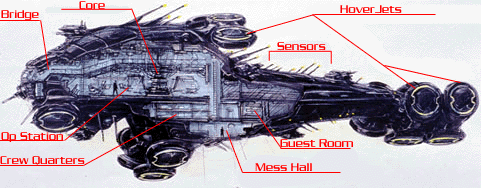
Communications: Capable of linking into the Zion communication
grid or the Matrix.
Sensors: capable of creating a 3D rendition of objects
detected.
Passive: 5km/0D
Scan: 10 km/1D
Search: 25 km/2D
Focus: 1 km/ 3D
Weapons:
Electromagnetic Pulse Wave
Fire Arc: Sends a
wave out in all directions.
Crew: 1
Skill: None (automatic)
Fire Control: None
Range: 100 meters
Damage: Causes automatic
shutdown of any electrical systems which are not shielded from electromagnetic
pulses.
Game notes: A hovership must power down most of its systems
to use the EMP Wave without damaging itself (considered going to minimal
power). If they do not, Sensors, Communications, Maneuverability
and all computers (including Jumpchairs) will cease to work. It takes
1d6 hours to repair each damaged system. If Jumpchairs lose power
or are damaged while in use, the Jumper will die.
Exoskeleton
Craft: Zion mechanized defense and construction exoskeleton.
Scale: Tank.
Height: 8 meters
Width: 6 meters.
Skill: Operate Exoskeleton
Speed: 2 mph / 4 mph / 10 mph / 20 mph.
Maneuverability: 0D.
Crew: 1.
Crew Skill: Operate Exoskeleton: 4D; Mounted Artillery:
4D
Armor Value: 30 (has no effect versus EM Pulses) for the
structure. Only provides an AV of 20 for the wearer.
Body Points: 85
Attributes: Strength: 12D (Character scale).
Strength/Lifting:
+10
Communications: Short-range communications on secure channels..
Sensors: extremely rudimentary sensors, usually receiving telemetry
from fixed sensor stations around Zion or from Hoverships.
Passive: 1 km/ 0D
Scan: 2 km/1D
Search: 1 km/2D
Focus: 0.5 km/ 3D
Weapons:
90 mm Cannons (2, one on each arm).
Fire Arc: Forward.
Skill: Mounted Artillery:
4D
Fire Control: 1D
Range: 100 m / 200
m/ 300 m
Damage: 8Dx5
(Tank Scale).
Ammunition: 200 rounds per
Cannon.
PROGRAMS
Many of those that access or live in the Matrix create new pieces of
code that are integrated into the system. Some of this code is simply
a reproduction of common place objects that a "normal" human would have
access to in the "real" world. For example, every time a human Operator
provides weapons in a Construct program that hackers take into the Matrix,
the Operator is essentially adding a code "object" to the Matrix.
Other such "objects" or programs are more complex. While they
may appear commonplace, they are actually designed to interface with or
manipulate the Matrix in subtle ways. For example, the well-known
"red pill" that is offered to a potential for resuscitation is actually
a trace program that helps the Resistance locate the physical location
of the potential's body in the Real World. These programs pierce
the veil of the Matrix.
The programs listed below are of the latter, more subtle types.
They are coded "objects" and routines which are designed by those who know
what the Matrix is and are trying to manipulate the code to their advantage.
These programs are divided into two main categories: Coded Drugs (items
that activate when inserted into or ingested by someone in the Matrix)
and Familiars (semi-autonomous programs that serve specific functions).
Terms:
Type: the name and/or basic function of the program.
Origin: the source of the original code for this kind
of program.
Typical Manifestation: the physical manifestation of the object
in the Matrix. Often, this is extremely mutable.
Program Level: a description of the complexity of the program
and an indication of its rariety (Basic, Standard, Complex, Advanced, Incomprehensible).
Difficulty to Program: the standard Difficulty Level for
a programmer to create this program or object.
Detection Risk: Difficulty Level that the program user
must surpass in order to avoid detection from the Machines.
Description: a brief description of the program's functions.
CODED DRUGS
Trace Program
Origin: Zion Resistance.
Typical Manifestation: a red pill, offered when the potential
is given the choice of learning the secrets of the Matrix or returning
to their old life.
Program Level: Complex
Difficulty to Program: Moderate (3). Trace programs must be
regularly retooled to defeat new security protocols put in place by the
Machines.
Detection Risk: Moderate (3).
Description: When ingested by a human in the Matrix, the
red pill disrupts the interface between the human and the cybernetic system
link in the human's stasis pod. This electronic disruption also acts
as a beacon that a Zion hovership can detect. The Machines believe
the pod has malfunctioned and eject the human into a "recycling" sewer
system. At that point, the Resistance has a brief window (usually
fewer than five minutes) to rescue the human from the recycling pool before
the person drowns or is ground up by the recycling processors and fed to
other humans still plugged into the Matrix.
Sleep Program
Origin: Zion Resistance.
Typical Manifestation: a blue pill, offered when the potential
is given the choice of learning the secrets of the Matrix or returning
to their old life.
Program Level: Complex.
Difficulty to Program: Moderate (3). The Sleep Programs
typically can be resused again and again because the Machines rarely notice
their use (and therefore do not develop defenses against them).
Detection Risk: Low (2).
Description: If ingested, this pill will render the target
unconcious and obscure memories regarding the Matrix or meetings with Resistance
hackers. The person will be left feeling as if they have had an extremely
odd dream.
Ecstasy Stimulant
Origin: the Merovingian (Autonomous Inform).
Typical Manifestation: the Merovingian likes to dress his Stimulant
programs up in a variety of guises, usually food, alcohol, or, occasionally,
illicit drugs. The Ecstasy Stimulant has been known to be manifested
as a decadent piece of chocolate cake.
Program Level: Complex. The target may make a Willpower
vs. 20 to avoid the effects.
Difficulty to Program: Difficult (4). This program is
Difficult because it has very subtle effects--sexually arousing its target
to the point of orgasm--and is absolutely hidden within an already-detailed
piece of code (the chocolate cake). It requires a very fine touch
to code something so elegant and effective.
Detection Risk: Very Low (1).
Description: When the target is subject to this program,
either through voluntary ingestion of a food item containing its code or
through other means, the target is overcome with feelings of sexual pleasure.
The target may be driven to the point of distraction even, perhaps, orgasm.
This is generally considered fairly benign, but the ability to so deeply
manipulate another being in the Matrix demonstrates an incredible dangerous
potential for abuse.
Enragent
Origin: the Merovingian (Autonomous Inform).
Typical Manifestation: like many of the Merovingian's programs,
the Enragent is often disguised as a food item. In his perverse sense
of humor, the Merovingian has been known to plug Enragent code into children's
candies, IV bags giving drugs to hospital residents, and dog food.
Program Level: Complex. The target may make a Willpower
vs. 20 to avoid the effects.
Difficulty to Program: Difficult (4). While the Ecstasy
Stimulant has somewhat benign effects, the Enragent is capable of wreaking
serious damage to its target or others around him. The code must
be written to overcome the target's natural sensibility and provoke a violent
anger.
Detection Risk: Low (2). Explosive effects, such
as mass murders or serial slayings, may be detected by the Machines who
may dispatch human police or Agents to investigate.
Description: The target of this program is overcome with
anger, welling up into a violent rage. Depending on the "dose" in
the code, the target may go from being merely irritated to homicidal in
a matter of minutes. Some believe that the Merovingian's Enragent "drug"
may have resulted in more than one postal worker shooting spree...The Merovingian
does seem to feed off the chaos and emotional turmoil that follows such
events.
Willcrackers
Origin: the Machines (typically used by Agents to extract information
from captured Resistance fighters).
Typical Manifestation: these often take the form of a "truth
serum" that is injected into the target.
Program Level: Very Complex. The target may make
a Willpower vs. 20 to avoid the effects.
Difficulty to Program: Very Difficult (5). The
program must be written to anticipate and overcome the target's mental
defenses. It works to trace the hacker's link back to his Hovership
and actually download information from the Hacker's brain.
Detection Risk: Unknown, but probably Fair (2).
Description: The battery of virtual "drugs" that Agents
use, collectively referred to as "Willcrackers" by Zion fighters, are the
source of much concern among the Zion leadership. Conceivably, the
Agents can use the drugs to open up a captured hacker's brain and gain
access to all the hacker knows of Zion's tactics and defenses. When
successful, the Willcracker leaves the target open to questioning from
an Agent and the target will be unable to lie (without an Extremely Difficult
Willpower check).
FAMILIARS
Familiars constitute programs with semi-autonomous features that serve
as lackeys, servants and pets for their creators. Typically, the
Familiar will take the form of a human or, on occasion, a standard pet.
However, the Familiar will often have very unique characteristics.
Sentry Dog
Origin: unknown. The Machines and some Autonomous Programs
are known to use Sentries as their "eyes and ears" when the investment
of an Agent or other resource-intensive program would be wasted.
Typical Manifestation: a German Shepard, Rottweiler, or Doberman.
Program Level: Very Complex. Complexity may be reduced
or increased depending on the program's AI.
Difficulty to Program: Very Difficult (5).
Detection Risk: Generally, Low (2) so long as the Sentry
conforms to the most of the normal parameters for a "dog" in the Matrix.
Description: This Sentry Dog acts like any normal guard
dog except that it records and transmits all of the stimuli it senses to
a remote station. Thus, a user may "see" through the Sentry's eyes,
even smell with its nose. And the controller can give immediate commands
to the Sentry, typically through a computer or voice interface.
The typical sentry has the following Attributes
and Skills:
Dexterity: 3D.
Run: 5D, Attack (Bite Strike): 4D, Dodge:
4D.
Perception: 4D
Track: 6D, Search 6D
Strength: 3D
Base Damage Value for Bite: 4Dx3
"Werewolf"
Origin: unknown. "Legend" has it that the Werewolves were
originally written by the Machines as part of early manifestations of the
Matrix, probably to serve similar functions as the Agents do now.
These programs have generally been "collected" by more powerful Autonomous
Programs to use as lackeys.
Typical Manifestation: a thuggish looking man or woman in a
sharp suit.
Program Level: Extremely Complex. A person may make
a Faith roll of greater than 20 to recognize that the Werewolf is merely
a program and not a real person.
Difficulty to Program: Extremely Difficult (5).
Detection Risk: Generally, Moderate (3). No one
knows when the last "werewolf" was created.
Description: Rumor has it that occasionally Autonomous
Programs become a bit too autonomous and begin "doing things they shouldn't"
(i.e., acting without direction from the Machines and outside their original
behavioral parameters). To hide the "illegal" activities of these
programs, the Machines folded the stories of these programs into the social
consciousness of the humans plugged into the Matrix. These outlaws
became the bogeymen of fairy tales or the space aliens of inumerable conspiracy
theories.
"Werewolf" is a generic name for one such program,
typically a violent one. These programs are often collected by Autonomous
Programs as items of study, curiosity, or simply utility (they follow orders
fairly well and kill with pleasure).
The typical Werewolf has the following Attributes
and Skills: Werewolves can typically be uploaded with new skills
quickly.
Dexterity: 5D.
Run: 6D, Martial Arts: 6D, Dodge: 5D, Melee
Weapons: 6D, Firearms: 6D, Throwing: 6D.
Knowledge: 1D
Tactics: 3D, Intimidation: 4D, Streetwise:
2D.
Mechanical: 2D
Drive: 4D, Drive Motorcyle: 4D. Often
has Aircraft and Weaponry skills.
Perception: 2D
Track: 3D, Search: 3D, Stealth: 4D
Strength: 4D
Climbing: 6D, Jumping: 6D, Stamina: 8D.
Technical: 1D
Special Abilities: Many werewolves are especially resistant
to damage and are very difficult to kill. Apparently, some versions
can only be killed by silver bullets. Others may have equally romantic
vulnerabilities.
Tracking Parasite
Origin: the Machines, typically used by Agents to track humans
that are moving through the Matrix.
Typical Manifestation: when inert, the Parasite resembles a
spark plug in a test tube. When activated, it has 8 ropy legs and
a robotic body that appears as a cross between a spider and a squid.
Program Level: Extremely Complex. Can be defeated
with a special device that "surgically" removes the Parasite from its host.
Difficulty to Program: Difficult (5).
Detection Risk: Very Low (1).
Description: The Tracking Parasites are only used when
a human that is still plugged into the Matrix begins to discover too much
about the true nature of the system or has too much contact with the Resistance.
Agents insert the Parasite into the host's body. Once inside, the
Parasite continually broadcasts the location of the host in the Matrix,
making them extremely easy to track. The Parasite also records and
broadcasts the observations of the host. The Resistance has come
up with many techniques for interfering with these broadcasts and removing
the Parasites from hosts.
Humans who are still plugged into the Matrix and
who are the recipients of a Tracking Parasite often report "alien encounters"
where they are abducted and subject to tests. These "abduction" tales
are usually discounted as fantasies or signs of mental instability.
Spybot
Origin: the Machines, typically used by Agents to eavesdrop
on suspected Resistance cells. Autonomous Programs have also been
known to develop varieties of Spybots.
Typical Manifestation: usually appears as a small insect, such
as a flea or a common house fly. Upon closer inspection, it will
be obviously robotic in origin.
Program Level: Complex. Spybots may be detected
with a Moderate or Difficult Sensors roll or a Very Difficult Search roll.
Saavy Resistance hackers know to either kill every fly zooming about a
room or to at least take a good look at them up close. Spybot transmitters
may also be jammed with a Difficult Communications roll (GM may adjust
at his discretion). Finally, some clever hackers have developed "predator"
insect-bots that patrol secure areas to hunt and kill spybots.
Difficulty to Program: Difficult (5).
Detection Risk: Very Low (1).
Description: Spybots act as video and audio transmitters
for those that want to covertly acquire information. Because the
Resistance Hackers have developed a variety of ways of operating in the
Matrix without being tracked or detected, the Machines have had to resort
to such measures to gather intelligence. Some clever Autonomous Programs
also use Spybots for their own ends.
Spybots are generally very fragile and can easily
be killed (any damage taken usually renders them inoperative).
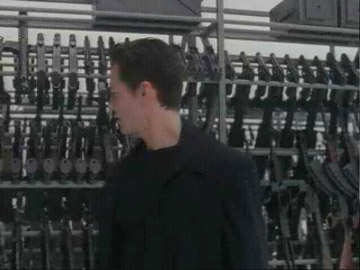

 Game
Notes: The Hackers employ advanced computers to monitor and jack
into the Matrix. Much of these computers has been stolen or salvaged
from the Machines and no two computers are identical. Some may have
special sensors, others more advanced A.I.'s. A skilled Operator
must be able to pay attention to multiple screens at one time, while reading
the complex Matrix code, and quickly access information and programs for
his Hackers.
Game
Notes: The Hackers employ advanced computers to monitor and jack
into the Matrix. Much of these computers has been stolen or salvaged
from the Machines and no two computers are identical. Some may have
special sensors, others more advanced A.I.'s. A skilled Operator
must be able to pay attention to multiple screens at one time, while reading
the complex Matrix code, and quickly access information and programs for
his Hackers.



